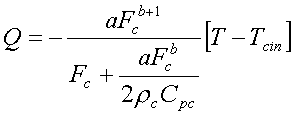
This question involves performing an energy balance around the system. The following equation provides an example of this energy balance.

Where heat transferred, Q is a function of coolant flow rate and temperature driving force. The relationship is derived in the textbook and summarized in the equation below. Eq (3.62)

When the energy balance is linearized, the terms become complicated and are simplified by the equations in Eq (3.65). Don't get bogged down with the details of the linearization, for now. The final result of the linearization is below.

Where the values of KT and KFc appear in eq. (3.65) and depend only on the coolant flow rate and the temperatures. They are independent of the flow rate, and the tank volume.

By continuing to follow the derivation performed in Example 3.7, the time constant and the gain can be evaluated.

Now we can consider the effects of changing the volume and the flow rate.
Firstly when we change the volume:
As for a change in the flow rate into the tank:
Example 3.7 uses the fundamental modelling procedure and extensive algebraic manipulation. Despite the more complicated algebra, the results are interpreted in the same way as with simpler models.